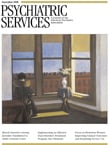Smoking Bans on Psychiatric Units: Boundaries and Health Promotion
To the Editor: On January 10, 2005, the Italian government implemented a law that bans smoking in all enclosed places. An emerging body of evidence shows that it is possible to introduce smoking bans in psychiatric units (
1,
2 ). However, many psychiatric settings in Italy lack a clear smoking policy.
In this letter we describe the impact on staff and patients of a complete smoking ban that was implemented in a 14-bed psychiatric emergency service that serves primarily an inner-city population in Turin, Italy. The service admits patients from the hospital's emergency department 24 hours per day. Six months before and six months after the ban was implemented, staff members completed a brief questionnaire about their attitudes toward the desirability of the smoking ban and its perceived impact on patients' mental status and the ward milieu. In addition, objective indicators of ward disruption were measured, including rates of aggression, use of PRN medications, need for restraint, elopement, and discharge against medical advice. Chi square tests were used to evaluate the impact of the ban on objective indices of ward functioning. Charts were reviewed for 248 patients discharged from the unit during the six months before the ban and 220 patients discharged during the six months after its implementation. No significant differences in demographic or clinical characteristics were found between the two groups.
Our analyses found no significant differences in objective indicators of ward disruption before and after the ban. Most of the monitored parameters of disruptive behavior remained stable; for other parameters the changes did not reach statistical significance. No changes were noted between the two periods in staff turnover or in problems related to staff illnesses or casualties. Staff members' responses to the questionnaire indicated that they initially disagreed with the new smoking policy. Such early opposition has been found in other studies (
3,
4 ). Spontaneous comments were generally negative, reflecting staff members' belief that patients need to smoke in order to relieve the stress and discomfort of their illness and to counter the side effects of drugs. Almost all respondents feared that the smoking ban would increase verbal and physical assaults. Staff members reported that they often used cigarettes to offer support, to manage threatening violence, and to reward appropriate behavior in difficult situations. The prospect of removing this bargaining tool and reward raised concerns that use of restrictive approaches, such as restraint, would increase. Only one respondent offered a positive comment, remarking that the patients and staff who did not smoke would appreciate a smoke-free environment.
Six months after the ban was implemented, questionnaire responses and spontaneous comments indicated that many staff members had changed their minds and appreciated the new policy. Many felt that the old approach was a typically paternalistic one in which cigarettes were used like tokens to keep patients quiet and that such an approach hindered staff from developing insights about patients and good relations with them. Staff reported that the new policy helped them find alternative ways of interacting with patients. Staff noted that when they used a cigarette as a reward, patients demonstrated the desired behavior just to obtain it. With the ban in place, staff found new ways to negotiate with and empower patients. Thus the new environment was not just physically healthier but also mentally healthier.
Smoking bans in institutional settings provide an opportunity for staff to work with patients on boundaries and limits. Staff helped patients manage their smoking behavior when patients were faced with the limitation imposed on their behavior by the ban. The situation provided a basis for staff to work with patients to manage other behaviors and gain insight about other limitations. In addition, helping patients understand limits is a key factor in the deescalation approach to managing psychiatric emergencies.
On the basis of our experience, we conclude that smoking bans in psychiatric settings can lead to better patient care, although such bans are often difficult to implement. Before the ban, it was clear that staff gave little thought to this problem. Some of them even believed that their smoking with patients had therapeutic value (
3,
5 ). However, after an initial phase of opposition, both patients and staff adapted to the new policy.

